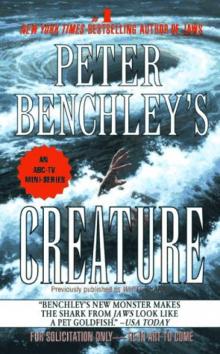- Home
- Peter Benchley
Shark Life: True Stories About Sharks & the Sea Page 5
Shark Life: True Stories About Sharks & the Sea Read online
Page 5
I, as the so-called talent, was sent into the water. Stan Waterman followed to film whatever happened. We had only expected to film the contrasting colors of the beautiful fish against the greenish blue sea, interrupted now and then by a black-rubber-suited human.
Back then I was still a pretty raw blue-water diver. Blue-water diving is diving in water with no bottom visible or reachable. I wasn't used to diving in water more than five thousand feet deep. Once in a while I was haunted by a vision of my body drifting down, down, down, from light blue to darker blue, to purple and violet and the unknown black.
So, naturally, whenever I had to dive in blue water, I carried a security blanket: a sawed-off broomstick about three feet long, attached to my wrist by a rawhide thong. Exactly what it was supposed to protect me from I'm not sure. But I thought if cameramen carried cameras they could use to ward off attackers, and assistants carried cameras and lights, why shouldn't I be allowed to carry a broomstick?
Thus armed, I jumped overboard and swam among the yellowfin tuna—or, rather, they swam around me. I held on to the barnacle-covered buoy chain to keep from being swept away by the current. The school of tuna, which had scattered when I splashed into the water, reformed and circled me. The shafts of sunlight piercing the surface glittered on their silver scales and yellow fins. It seemed to me that Stan must be gathering an entire library of beauty shots.
The water was very clear. I was sure visibility was more than a hundred feet, though it's hard to tell in blue water, for there's nothing visible against which to gauge distances.
At the very edge of my vision I saw a shark swimming by. I couldn't tell what kind it was, and I didn't much care, for it showed no interest in me or the tuna.
Meanwhile, far up on the bow of the boat, one of the crew—bored and tantalized by the sight of so many delicious meals swimming so close to the boat—rigged a fishing rod. He dropped a baited hook into the water and let it drift back into the school of tuna. He had not asked permission, nor had he told anyone what he was doing. After all, he was staying out of the way and minding his own business. When he hooked a fish, he would simply haul it aboard, and no one need be the wiser.
Stan gestured for me to move away from the buoy so that he could frame me and the fish cleanly against the blue background. I let go of the chain and kicked my way out into open water. Obligingly, the tuna followed.
Suddenly I was gone, jerked downward by an irresistible force, with a searing pain in my lower leg, arms flung over my head, broomstick aimed at the surface. I could see Stan and the tuna receding above me. I looked around, panicked and confused, to see what had grabbed me. The shark? Had I been taken by the shark? I saw nothing.
I looked down. I was already in the dark blue; all that lay below was the violet and the black. Wait … there, against the darkness … what could it possibly—
A tuna, fleeing for the bottom, struggling, fighting … fighting? Against WHAT?
Then I saw the line, and the silvery leader. The fish was hooked! Somehow it had gotten … No, impossible, no way it could have—
A cloud billowed around my face, black as ink, thick as … blood. My blood.
I leaned backward and kicked forward, wanting to see my feet.
The steel leader was wrapped around my ankle. The wire had bitten deep, and a plume of black was rising from the wound. That was a sign that I was already down very, very deep, for blood doesn't look black till the twilight depths. (The sea consumes the visible spectrum of light, one color at a time, beginning a few feet underwater. Red disappears first, then orange, yellow, green, and so on. When you reach 150 or 200 feet, blood looks black.)
All I could guess was that as the fish had fled the surface, it must have passed between my legs, or circled around my feet, or somehow wrapped the leader around my leg. And all I knew was that, somehow, I'd better find a way to free my leg before I was taken so deep that I would never return.
I reached for my knife, to cut the line. But first I couldn't find the knife, and then I couldn't release it.
The tuna stopped diving and turned. That relieved the pressure against its mouth and must have convinced it that it was free, for it swam upward, toward me.
The line slackened, and I slid my foot and fin out through the widening coil.
Giddy with relief, I checked my depth and air gauges: 185 feet deep, 500 pounds of air. That was more than enough for a controlled ascent.
I started up, slowly, and now the black blood no longer billowed around me but trailed behind. The pain in my leg had waned, and my foot seemed to be working, which meant that no major tendon had been cut.
I passed a hundred feet, then ninety, eighty. … Things were lighter now, visibility had returned, and I could see the rays of the sun angling down from the shimmering surface. Everything would be okay, after all. There was noth—
The shark came straight for me, emerging quickly from the blue haze. Its fins formed a lopsided triangle because of the slight downward curve of the extraordinary pectorals.
Ten, maybe fifteen feet from me it veered away. It banked downward and passed through the trail of blood leaking from my ankle. Now it was sure that I was the source of the tasty scent it had picked up from far away. It rose again, leveled off before me, and began the final stage of the hunt.
It's hard to be sure of sizes underwater. The generally accepted rule is that animals look about a third again as large as they actually are. This shark looked ten or twelve feet long, which meant that, in fact, it was probably seven to nine feet long. But “in fact” didn't matter to me. All I cared about was that the closer this shark came, the bigger it looked, and it was very big.
It circled me twice, perhaps twenty feet away. Then it gradually began to close the distance between us. With each circle, it came closer, first by six inches, then by twelve, then fifteen.
I raised my broomstick and held it out like a sword, waving its blunt tip back and forth. I wanted the shark to know that I was a living being armed with the weapons and determination to defend myself.
Longimanus was not impressed. It circled closer, staying just beyond the reach of the broomstick. I could count the tiny black dots on its snout. Those dots are called the ampullae of Lorenzini, and they carry untold megabytes of information, chemical and electromagnetic, to the shark's brain.
The mouth hung open about an inch, enough to give me a glimpse of the teeth in the lower jaw.
I turned with the shark, trying to maintain some upward movement. I watched the eye—always the eye—for movement of the nictitating membrane. That would be the signal that the threat display was ending and the attack itself beginning.
It quickened its pace, circling me faster than I could turn. So I began to kick backward as well as upward, to increase the distance between us.
I jabbed randomly with the broomstick, never touching flesh, never causing longimanus even to flinch.
I glanced upward and saw the bottom of the boat, a squat, gray-black shape perhaps fifty feet away, forty-five, forty. …
The shark appeared from behind me, a pectoral fin nearly touching my shoulder. The mouth opened, and the membrane flickered upward, covering most of the eye. The upper jaw dropped down and forward, and the head turned toward me.
I remember seeing the tail sweep once, propelling longimanus forward.
I remember bending backward to avoid the gaping mouth. I remember the ghostly, yellowish white eyeball, and I remember stabbing at it with the broomstick.
I don't remember hitting, instead, the roof of the shark's mouth. But that's what must have happened, for the next thing I knew, the shark bit down on the broomstick. It shook its head back and forth to tear it loose. When that failed, it lunged with its powerful tail, intent on fleeing with its prize.
The broomstick, of course, was attached to my wrist. I was suddenly dragged through the water like a rag doll, flopping helplessly behind the (by now) frightened shark. It had taken a test bite from a strange, bleeding prey and now
found itself dragging a great rubber thing through the water.
Breathing became difficult; I was running out of air.
I tried to peel the rawhide thong off my wrist, but the tension on it was too great and I couldn't budge it.
I was on my back now, upside down, my right arm over my head as longimanus towed me away from the safety of the boat. I could once again see blood trailing from my leg. At this depth it was dark blue, and it streamed behind me like a wake.
Everything stopped. At once. My arm was free, and I was floating about thirty feet beneath the surface. I looked at the broomstick—or at what remained of it. Longimanus had bitten through it.
Far away, at the outer limits of my sight, I saw the black scythe of a tail fin vanish into the blue.
I sucked one final breath from my tank, opened my mouth, and tipped my head back. I kicked a couple of times and rose up to the kingdom of light and air.
Not until I reached the swim step at the stern of the boat did the weakness of fear overcome me, and the shock.
I spat out my mouthpiece, took off my mask, and started cursing that so-and-so of a shark.
“No!” said the director. “No, no, no. You can't use that language on network television. Go back down and surface again and tell us what you saw.”
MAKOS AND BLUE SHARKS
The final two sharks on my personal list of species to be wary of could not be more different from each other. One, the mako, is a loner that's sleek, silent, and vicious. The other, the blue shark, is a pack animal that rarely bothers anyone. But it has, on occasion, killed human beings floating in the ocean. Because it is a pelagic (open-water) shark like longimanus, the blue shark is vulnerable to large commercial fishing operations. Over the last ten years, populations of blues all over the world have been devastated.
The mako is one of the fastest fish in the sea—far and away the fastest shark. It is the only shark listed by the International Game Fishing Association as a true “sport fish.” The feel of most sharks on a fishing line is like hauling on wet laundry or trying to lift a cow. Fighting a mako has been compared to riding a bull or wrestling an enraged crocodile.
Makos leap completely out of the water, turn somersaults, and “run” in any and all directions in their frenzy to escape. Hooked makos have been known to charge boats and jump into open cockpits, where they've gone berserk and destroyed the craft that has hooked them. (A mako can weigh more than a thousand pounds.) Some fishermen have jumped overboard rather than risk being beaten to death by the flailing fish. A few have tried to subdue maddened makos by shooting at them with high-powered rifles—a dangerous move, because of possible unintended consequences such as putting a hole in the boat, or in a companion.
While the body of a mako is one of the most beautiful in the sea, its face is positively ugly. A mako looks mean. Its teeth, upper and lower, are long, pointed, sharp as needles, and snaggly. A great white's teeth speak to me of quick, efficient death. But a mako's teeth warn of a nasty end, of flesh ripped into ragged chunks. A mako's eye, too, is distinct from every other shark's. To me, at least, it looks crazed and threatening, ready at any second to explode into unstoppable violence.
A mako's speed, however, is its most dazzling weapon. Especially over short distances—like the range of visibility in most water conditions—it can appear and disappear as if by magic. It's a gray ghost in the distance one second, right in front of you the next, gone the next, back again the next.
A friend of mine was snorkeling in shallow water in the Bahamas a few years ago. He was poking the sand bottom with a long metal rod in search of buried cannons or shipwreck wood. When he glanced up he noticed a shark cruising at the far limit of his vision. Here's what he recalls:
“I didn't give it a thought, didn't pay any mind to what kind it was. Before my eyes had refocused on the bottom, it hit me. Out of nowhere. I never saw it coming. All I knew was I felt like I'd been hit by a freight train. My mask was knocked off, both flippers came off, I dropped the spear, and suddenly the water was full of blood. Mine. The mako had hit me just once, a glancing blow, tore up my thigh pretty badly. I could see him off a ways, hanging there, like he was deciding whether or not I was worth eating. Then—poof!— he was gone. I guess he figured I was too bony.”
Bony, perhaps; lucky, definitely.
ANY SHARK CAN RUIN YOUR DAY
Don't take as gospel my (or anybody's) list of bad actors in the company of sharks. All such lists are subjective. Mine includes only sharks that either I or my colleagues have had trouble with. Some folks, for instance, have reason to be scared of hammerheads. Others have had unhappy run-ins with gray reef sharks.
What you should take as gospel is that any shark can be dangerous. Still, most injuries inflicted by reputedly inoffensive sharks are caused by human error or ignorance.
Nurse sharks, for example, are among the gentlest of all shark species. The common peril people face from them is being bumped by them as they flee. I know of one diver, however, who entered a cave and saw a nurse shark sleeping in the sand. He pulled the shark's tail to get it to move. The shark moved, all right. Startled awake, it spun around in a frantic blur and bit the man in the throat (missing an artery by a couple of millimeters). It tore a gold chain from his neck, and as it fled the cave, it knocked the man spinning against the rock wall.
Over a single August weekend in 2001, in the single Florida county of Volusia, six people were bitten by sharks that they had seen before they entered the water. The sharks (most were blacktips) had gathered to feed on schools of baitfish. The people had gathered for a surfing contest. Too impatient to wait for the sharks to finish feeding and leave the area, the surfers chose instead to wade among and step over the feeding sharks.
That only six were bitten seems to me a miracle.
Other attacks have happened to people who ignored, or were ignorant of, the basic rules that help keep the chances of an attack to a minimum. They swam at dawn or at dusk; they swam alone; they swam far from shore or where fish were feeding or birds were working.
On August 19, 2003, Debra Franzman, age fifty, was swimming with seals at Avila Beach, California, when she was fatally bitten by a great white shark. She was wearing a black wet suit with a black hood, booties, and gloves. To the shark she undoubtedly looked like a wounded (or extremely clumsy) seal floundering around on the surface. As risky as such behavior sounds—and is—she had apparently been swimming with those same seals and wearing that same costume nearly every day for ten years—completely without incident.
Elsewhere in the world, a man was almost killed when he tried to hitch a ride on the back of a whale shark, as harmless a giant as ever roamed the sea. When he grabbed the enormous dorsal fin, his hand slipped; then he slipped. He hung in the water, watching, as the great speckled body moved beneath him like a ship. He forgot that this ship was driven not by a propeller but by a tail as tall as he was and as hard as iron. The sweeping tail clubbed him from behind, leaving him breathless and senseless. He survived only because an alert buddy located his regulator mouthpiece, rammed it into his mouth, and purged it—forcing air into him. Then the buddy inflated his vest, which lifted him to the surface.
There is one circumstance under which any shark of any size will eat a human being without hesitation. That is if the person is dead.
Sharks are scavengers. Scouring and clearing the ocean of animals that are weak, weary, or dead is one of a shark's most valuable functions.
8
Swimming Safely in the Sea
At approximately nine o'clock on the morning of July 23, 2001, four young cousins—three girls and a boy, aged eleven to sixteen—waded into knee-deep water at a beach in Far Rockaway, Queens, New York. The lifeguards assigned to the beach were not scheduled to begin their shift for another hour. But the cousins were with an adult, an uncle, who was aware of the dangerous currents off this particular stretch of beach. He warned his nieces and nephew not to go into the water, while he prepared fishing rods
and fetched food for their picnic.
The girls and boy probably thought they were obeying; wading wasn't really going into the water.
Within minutes, three of them were dead.
While the uncle's attention was elsewhere, all four had been yanked off their feet by the waves. They were grabbed and dragged underwater by a current so violent that it had already earned the area its local nickname—“the death trap.” Only one of the kids, the eleven-year-old boy, managed somehow to escape the grip of the current and get back to shore.
The next day's newspapers were full of warnings against swimming on unguarded beaches. Officials warned about the price the public pays for ignoring regulations.
But the real reason those three girls drowned and about 3,500 other people in the United States drown every year has nothing to do with rules, regulations, or lifeguards.
It has to do with the public's unfamiliarity with the ocean and its ignorance about swimming safely in it.
According to the American Red Cross, more than 54 percent of Americans—perhaps as many as 140 million people—say that their primary leisure activity is swimming. That's more than all our golfers, tennis players, sailors, scuba divers, and Frisbee players combined. Off the record, though, those same Red Cross officials say that only about 12 percent of those swimmers are actually competent in the water.
And who knows what tiny fraction of that 12 percent are competent ocean swimmers. That's a specialty that takes as much knowledge, training, and experience as rock climbing or kayaking. A Red Cross–certified beginning swimmer is about as close to a skilled ocean swimmer as a licensed driver is to an Indianapolis 500 contestant.
The United States has 12,383 miles of shoreline. Much less than 1 percent is patrolled by lifeguards on any given day. So if, on a hot summer day, you're struck by a sudden urge to swim in the sea, the odds are that there won't be a lifeguard nearby to keep an eye on you.

 Peter Benchley's Creature
Peter Benchley's Creature The Island
The Island Rummies
Rummies The Girl of the Sea of Cortez: A Novel
The Girl of the Sea of Cortez: A Novel Time and a Ticket
Time and a Ticket Jaws
Jaws The Deep
The Deep Q Clearance
Q Clearance Shark Trouble: True Stories and Lessons About the Sea
Shark Trouble: True Stories and Lessons About the Sea White Shark
White Shark Shark Trouble
Shark Trouble Shark Life: True Stories About Sharks & the Sea
Shark Life: True Stories About Sharks & the Sea